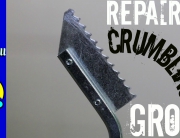Get a Stunning Paint Job With the Right Tools!
Purchasing good quality supplies is always a good start towards a beautiful paint job.
Brushes: Purchase the right brush for the job, and make sure it is a good quality brush. Not even a professional painter with many years of experience can deliver great results with an inferior or cheap brush, so it makes sense that you should use quality brushes as well.
How can you tell if you’re purchasing a premium brush? The answer can be found in the paint bristles, and whether or not you can feel their flagged ends with the touch of your hand. A flagged end is a split end, and split ends are a good thing for a premium brush to have because they will deliver a superior finish. It’s kind of funny to hear a split end described as a good thing, isn’t it? When painting an interior room, it’s always a good idea to have at least one 1-1/2 inch trim brush, preferably a sash brush (angled bristles), which will give you more control, especially in those tight spots.
It is also convenient to have a larger brush as well. 3-1/2 to 4 inches is the perfect size for cutting in corners. Remember, use a synthetic brush with latex paints and a natural bristle brush or synthetic approved brush when painting with oil finishes.
Roller: You have a few choices here. You can purchase the disposable type of roller sleeves and discard them after each use or you can spend a little more and purchase the reusable kind that with proper care can last through several painting projects. Another factor is that the disposable type tend to provide less-than-stellar results. Now, as far as nap, keep in mind that the denser the nap, the more paint the sleeve can carry. Textured walls and ceilings generally require at least a 1/2″ nap, and where a smooth finish is desired (such as doors), a smaller nap, usually 3/8″ is best.
Drops: There are a few disadvantages to using plastic drops. Though plastic drops protect the surfaces beneath them from spills, any paint dropped remains wet on the plastic surface and then is easily tracked to other parts of the house where floors may not be protected. In addition, very thin plastic drops are difficult to separate and unfold to their full size, tear easily, billow and move with the slightest breeze. You’ll be better served if you limit the use of plastic drops to protecting furniture.
For the floor, invest in a good quality canvas drop cloth. They’re washable, the investment is relatively small ($25-$40), and you will have it to use for many years to come. If you’re painting on a budget, sometimes an old sheet can suffice, but if you spill paint, clean it up promptly because bed sheets are not moisture-resistant and the paint will quickly penetrate to the surface below.
Storage: Paint brushes should be washed out thoroughly with warm water and mild soap after each use, even when paint projects are completed and need to resume the following day. A roller, however, can be stored in plastic kitchen wrap and then placed securely in a plastic grocery bag for the next day.
BY SEE JANE DRILL, Copyright 2016, All Rights Reserved







Hey Leah–
I’ve been painting for years and didn’t know about using the curve in the 5/1 tool and paint sticks, and never thought to use the plastic bag on the tray. Duh!
And I’ve been saying to my self “YOU can DO this!” about things I want to do in my life, and it helps.
Thanks for what you do!
Hi Davina,
That’s nice to hear! Thanks for writing.
Regards,
Leah
Your videos are fabulous. ,having run a paint crew with my old construction company, I learned great tricks from my former union painters. Now as a teacher at a university I’m trying to teach my students good practices on a build they do every year. Your videos mean I don’t need to be on site for everything shift to have good practices in painting. Thanks for your great, clear, accurate video!!st r I susare ep iwppub are re e
Thank you, Annie. It is great to hear that you are using our videos to help teach your students. that is awesome. 🙂